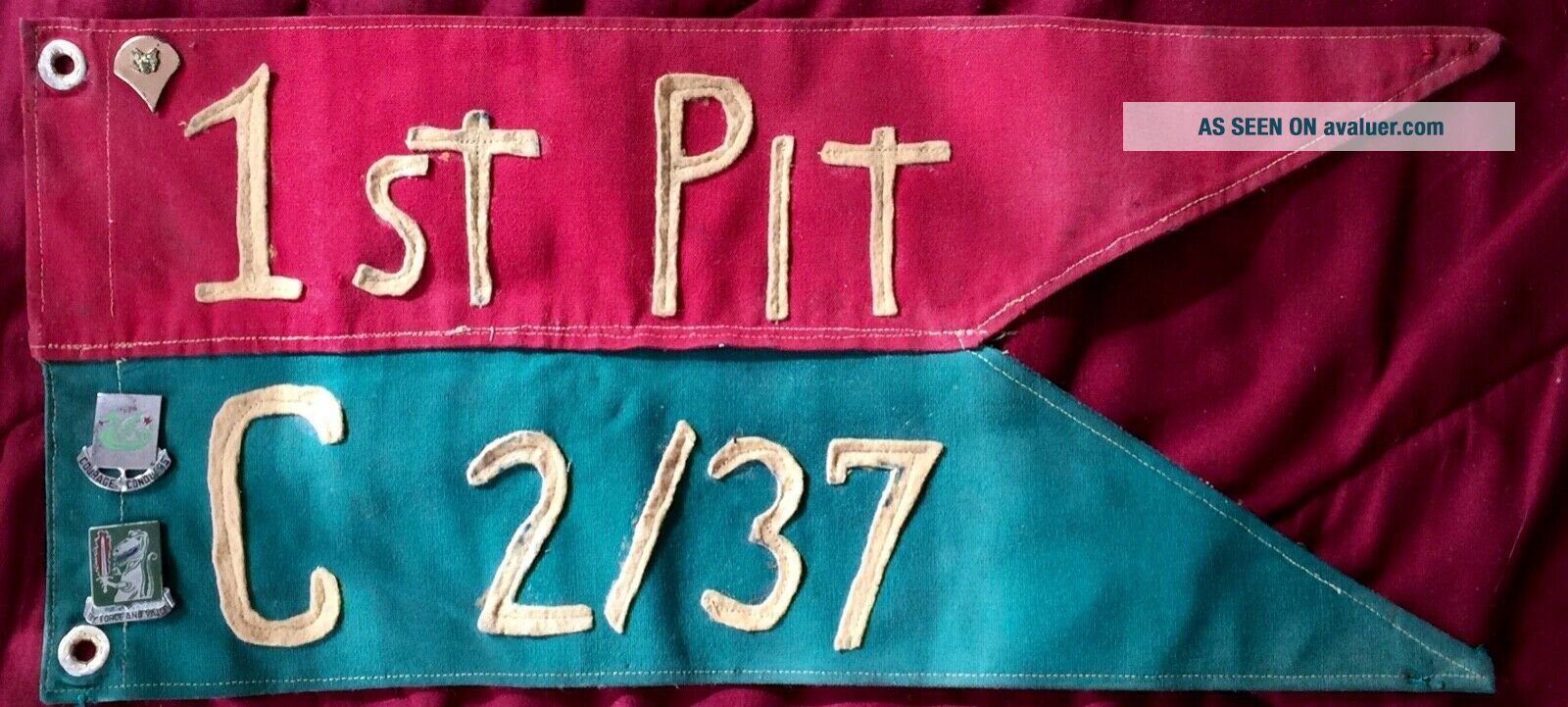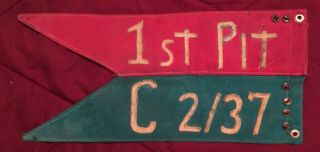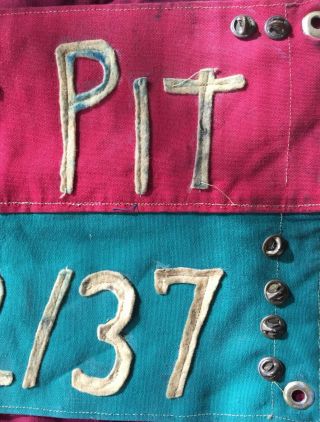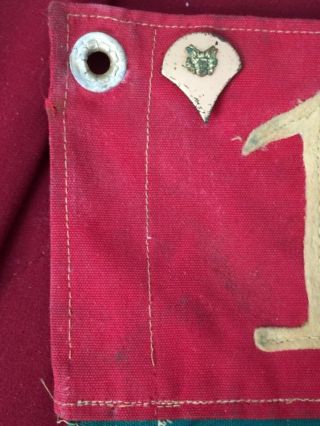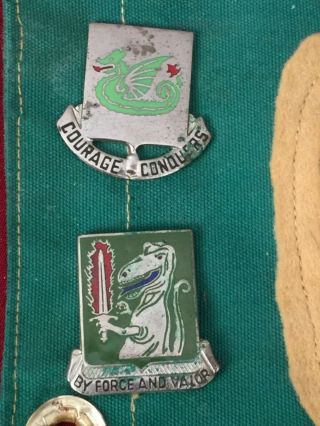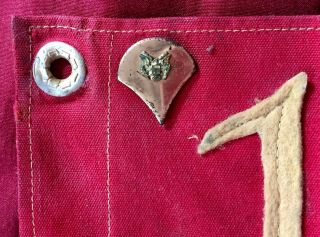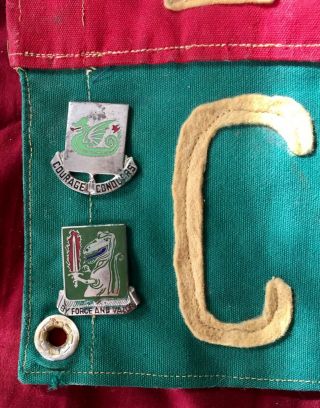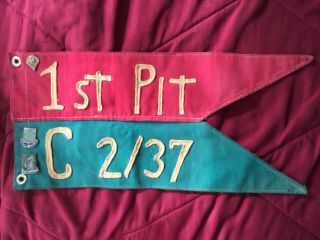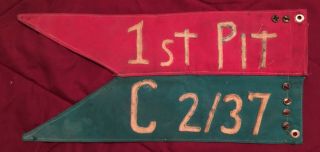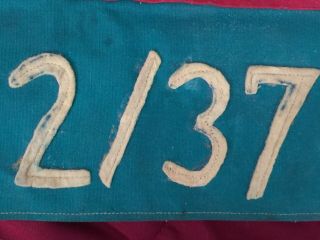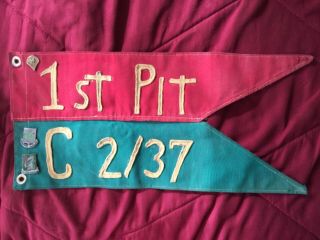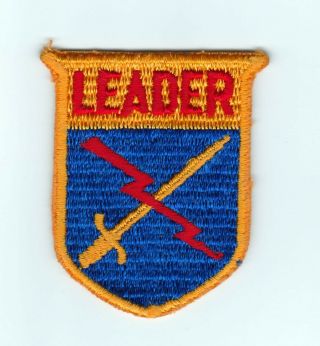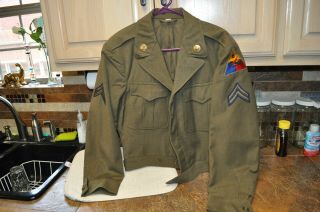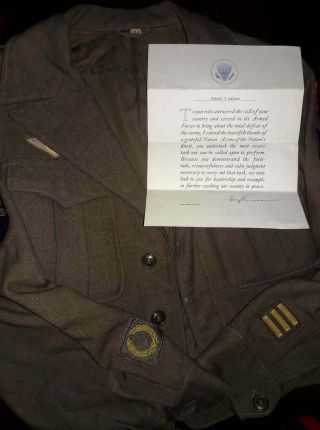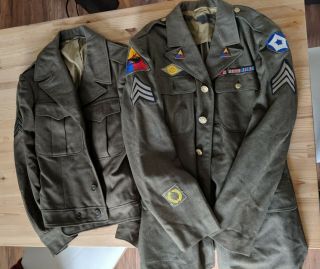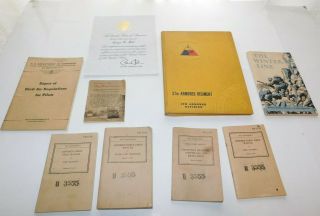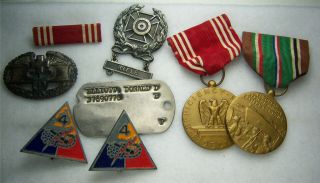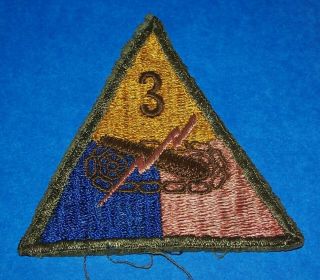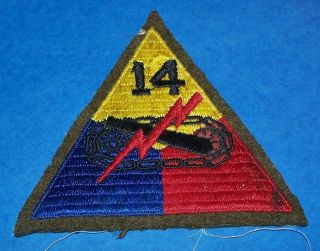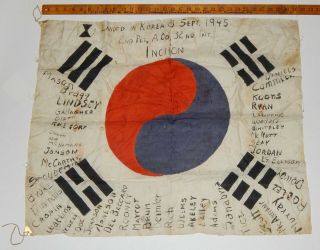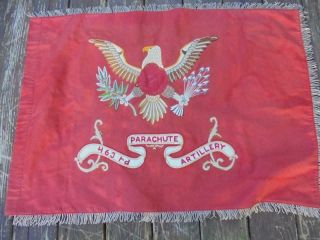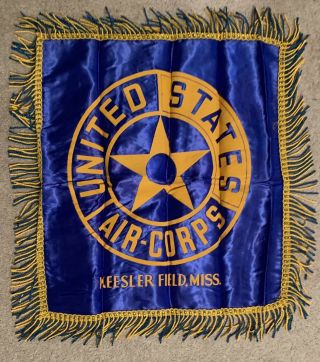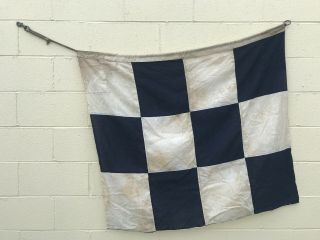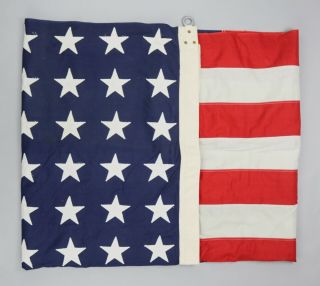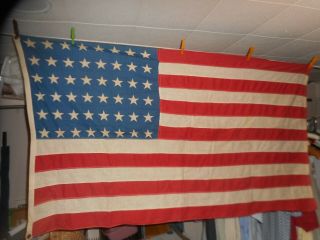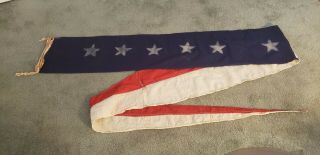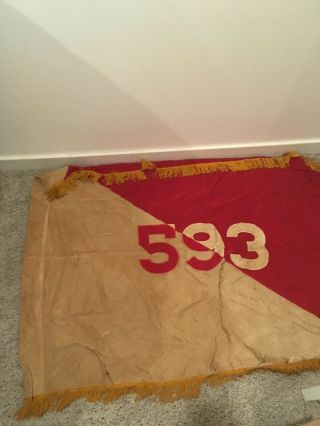WW2 37th Armored Reg’t Guidon 4th Armored Division FIELD MADE GUIDON
Item History & Price
| Reference Number: Avaluer:251475 | WW2: Flag |
| GUIDON: WW2 | Country/Region of Manufacture: United States |
| US: Flag | American: Flag |
| World War 2: Flag |
This is an Original WW2 2nd Battalion, 1st Platoon, C Company, 37th Armored Regiment Guidon. This guidon is theater made. This Guidon is made of a Red and Green cotton bunting from multiple pieces and a yellow felt sewn onto the Red and Green fields. This Guidon is hand made. This guidon would have been made between 1942 and 1943. This is the VERY EARLY WAR period.
This piece would have been made in Tennessee, California, or Texas during training. This is a true piece of V...ERY EARLY ARMORED REGIMENTAL HISTORY. During this period there were very few tanks to go around in the beginning of their training there was only 21 tanks in the entire 4th Armored Division.
***************************************************************************************Here’s 3 facts that show this to be a WW2 Armored Guidon
1) The 37th Armored Regiment's Headquarters and Headquarters Company (HHC) and its 1st Battalion and 2nd Battalion (less Company D) were redesignated as the 37th Tank Battalion. The 2nd Battalion 37th Armored wasn’t re-established until 1958.
2) Armored was assigned the colors green and white by circular 49 on 21 February 1947. When the Cavalry Branch was abolished, the present Armor was assigned the former Calvary color yellow by SR 600-60-1 dated 26 October 1951.
3) The colors of this Guidon, Red/Green predates Army circular 49 from 21 February 1947. The 2nd Battalion 37th Armored Reg’t was redesignated with HHC and 1st Battalion of the 37th Armored Reg’t to the 47th Armored Battalion. The 2nd Battalion 37th Armored wasn’t re-established until 1958. By that time Armored Guidons were yellow with the M-26 Pershing Tank in the center of the Guidon.
THIS IS WITHOUT A DOUBT A COMPLETELY ORIGINAL FIELD MADE 37th Armored Reg’t GUIDON from WW2 dating Between October 1942 and September 1943.
*****************************************************************************************
This Guidon is theater made, hand sewn on red and green bunting. This piece is double sided. On the red field it reads “1st PIT”, on the green field it reads “C 2/37”. There are 2 unit crests and a specialist pin. The 2 crests are for the 37th Armored Reg’t and 40th Armored Reg’t. The grommets are homemade.
This piece is faded, and there are staple marks on the swallow tail end.
*****************************************************************************************
This is the history of the 37th Armored Regiment
The 37th Armored Regiment (37th Armor) was constituted 13 January 1941 in the Regular Army as the 7th Armored Regiment (7th Armor) and assigned to the 4th Armored Division (4th Armored) when the Armored Division was activated on 15 April 1941 at Pine Camp (now Fort Drum), New York. The 7th Armor Regiment was redesignated the 37th Armored Regiment on 8 May 1941. The first filler personnel arrived at Pine Camp four days later, and two weeks after that a thirteen-week basic training cycle was begun. Training in the fundamentals of armor began, despite the fact that there were only twenty one tanks in the entire 4th Armored Division. Many of the 37th Armor's key personnel were selected to cadre the 8th Armored Division.
********************************World War 2In October 1942, the 4th Armored Division moved to Camp Forrest in Tullahoma, Tennessee on the Cumberland Plateau for maneuvers. In November, they moved again, to the West Coast Desert Training Center, first occupying Camp Ibis near Needles, California, California (in the Mojave Desert) and the Arizona and Nevada borders. During this time, some of the lessons learned in combat in North Africa by the 1st Armored Division and 2nd Armored Division were taught to the 4th Armored Division. In early June 1943, orders came for the 4th Armored Division to dismount at Camp Bowie, an Armored Division training center near Brownwood, Texas.
On 10 September 1943, the 4th Armored Division including the 37th Armored Regiment was reorganized in a new table of organization and equipment for most U.S. armored divisions. The 37th Regiment's Headquarters and Headquarters Company and its 1st Battalion and 2nd Battalion (less Company D) were redesignated as the 37th Tank Battalion.
The 3rd Battalion was reorganized and redesignated as the 706th Tank Battalion and relieved from assignment to the 4th Armored Division. The 706th spent the war as a separate battalion. Reconnaissance Company was redesignated and reorganized as Troop F, 25th Cavalry Reconnaissance Squadron, Mechanized, a separate element of the 4th Armored Division – hereafter separate lineage. Maintenance and Service Companies were disbanded, with the personnel and equipment distributed throughout the two battalions. Following the reorganization, the 706th Tank Battalion deployed from the San Francisco Port of Embarkation on 22 March 1944 and arrived at Hawaii on 29 April 1944. From there, they deployed on LSTs in support of Admiral Chester Nimitz' wing of the Pacific Island Hopping Campaign. 706th Tank Battalion was on Guam by 22 July 1944; on The Philippines by 23 November 1944; on Ie Shima by 16 April 1945; and on Okinawa by 25 April 1945.
The 37th Tank Battalion (37th TB) was now, together with the 35th Tank Battalion and 8th Tank Battalion (redesignated from 3rd Battalion, 35th Armored Regiment), the nucleus of the 4th Armored Division. On 15 November 1943, Major General John S. Wood who commanded the 4th Armored Division, announced that the 4th Armored Division would deploy overseas. On 11 December 1943, the 4th Armored Division moved northeast by train, unloading at Camp Myles Standish, Massachusetts, on 20 December 1943 for winter training. The 4th AD sailed from the Boston Port of Embarkation on 29 December 1943. They arrived in England for more training on 8 January 1944, and – after getting used to the local environment, and waiting for the D-Day invasion success at Normandy on 6 June, they proceeded to France on 11 July 1944 as part of the follow-on force.
***********************************Arrival in France, July 1944 The 37th Tank Battalion moved to Southern England and prepared for transport to France. On 13 July 1944, the 4th AD and the 37th TB reached Utah Beach, but for the most of the remainder of July 1944, the 37th simply waited in reserve as the 4th AD relieved elements of the weary 4th Infantry Division.
The 4th Armored Division was ordered to combat on 28 July 1944, as the U.S. First Army launched its breakout attack. The infantry divisions on both sides of the 4th AD attacked and "pinched out" the division, then the 4th AD attacked through the infantry divisions lines and began to race for the neck of the Brittany peninsula. The 37th was traveling at the forefront of this move with Colonel Bruce C. Clarke's Combat Command Alpha (CCA). The next day, Coutances fell, and then Avranches, at the northern edge of the neck of Brittany, fell on 30 July.
On its way across Brittany, the 4th Armored became part of General Patton's Third Army when it became operational on 1 August 1944. By 9 August 1944 the 37th was approaching Lorient, on the southern edge of Brittany. On 14 August 1944 the siege of Lorient was turned over to the 6th Armored Division and the 37th turned eastward with the rest of the Third Army, which was beginning its historic race across France. VII Corps was the southernmost corps of the Third Army, 4th Armored Division was on the VII Corps southern flank, and the 37th Tank Battalion was protecting the southern flank of the division. There was nothing south of the 37th except the Loire River and the Germans.
The commander of the 37th Tank Battalion, Lieutenant Colonel Creighton W. Abrams (who later became commander of all U.S. Forces in Vietnam and then the Army Chief of Staff), in an odd move, detached a task force under Major Edward Bautz to blow up the Loire River bridges between Blois and Tours, but they found upon arrival that their work had been done by the Wehrmacht. This task force then followed the Loire's northern bank, paralleling the advance of the main body. On 16 August 1944 a German column was sighted on the south bank. Major Bautz's tankers attacked this column, inflicting losses and driving the Germans back from the river.
The 37th crossed the Seine on 25 August 1944, and the Marne on 23 August 1944. The Marne Canal was bridged and the town of Châlons was attacked from the east, to the consternation of the defending garrison, which was expecting an assault on the western edge of town.
On 31 August 1944, in a quick attack during a driving rainstorm, the 37th captured the bridge across the Meuse River at Commercy before the Germans could blow it up. The next day, the gasoline ration had run out, and the 37th ground to a halt. By this time, the 37th had advanced 700 miles (1, 100 km) in seven weeks, crossed three major rivers and was within one day's motor march of the German border, only seventy miles to the northwest.
On 13 September 1944, the M4 tanks of the 37th crossed the Moselle River. On 14 September 1944 they overran the rear command post of the 15th Panzer Grenadier Division at Arracourt and, in Valhey, caught the same division's forward echelon command post before it could retreat. It was at Valhey, that Sergeant Joe Sadowski of Company A, 37th Tank Battalion, would become a Medal of Honor recipient. This non-commissioned officer from Perth Amboy, New Jersey was commander of the second tank column as the 37th rolled into the French town. Swinging north around a corner, Sadowski's M4 tank clattered into the village square, where a German armor-piercing round found its mark and set the Sherman afire against the town's water trough. Sadowski had his crew dismounted and took shelter behind a building after running a gauntlet of machine gun and small arms fire. The bow gunner was found to be missing, and a quick glance at the burning tank showed the gunner's hatch still closed tight. Sadowski ..."ran back to his tank, clambered up the smoking front slope plate and tried to pry open the gunner's hatch with his bare hands. He stood on the smoking tank and strained at the hatch until he had been hit so many times he could no longer stand. He slid from his medium [tank] and died in the mud beside its tracks".[1] His father and mother were given his posthumous Medal of Honor.
From 19 September through 22 September 1944 the Germans tried to push the 37th back across the Moselle River. At Moyenvic, the 37th saw one of the largest tank-to-tank engagements of the war, losing 14 Sherman tanks while claiming to have knocked out 55 Panther and Tiger tanks. The German counterattack was unsuccessful.
On 22 September 1944 the 37th's M4 tanks swept south again through Coincourt and Bures to the Rhine-Marne Canal. Counterattack followed counterattack as the desperate Wehrmacht tried to dislodge the 3rd Army from its position, but as the toll of Panthers mounted, the attacks dwindled in intensity and finally ceased. The 37th was relieved on 12 October 1944 by elements of the 26th (Yankee) Infantry Division. For its tenacity in the Moselle River valley, the 37th was awarded (4th AD cited) its second French Croix de guerre with Palm (its first when the 4th AD was cited for Normandy). The 37th's tankers were pulled off line for a rest after 87 straight days of combat.
The 37th moved out in a downpour on 9 November 1944 to deprive Hitler of the industrial Saar River Valley. On 11 November 1944 the 37th was caught on the road and lost six tanks because they could not maneuver off-road due to the bottomless mud. On 8 December 1944 the 37th passed through the old French Maginot Line and took Singling. Two days later it was relieved again, by elements of the 12th Armored Division, and sent to the rear for another rest, although not so far back that elements of the battalion were not in intermittent contact with German forces.
******************************Battle of the BulgOn 16 December 1944, Sherman tanks of Company A, 37th Tank Battalion were the first 4th Armored Division vehicles to enter Germany when they chased several German tanks back into the woods near Rimling. The same day Company A entered the Reich, Hitler had played his last trump north of where the 4th Armored Division was resting from its five months in action. The German 5th Panzer Army, the last of the German strategic reserves, spearheaded the attack by Field Marshal Model's Army Group B that opened the "Battle of the Bulge". Its objective was the port of Antwerp and allied depots nearby.
On 18 December 1944, the 37th got its march order—to move north against the German penetration, which was causing alarm to the Allied High Command. On the same day, the 101st Airborne Division was moved by truck to establish a strongpoint at the key road and rail junction of Bastogne, in Belgium. By the time the 37th arrived at the south flank of the German penetration, the 101st Airborne was cut off on all sides by the enemy drive. The 37th became the spearhead of the 4th Armored Division's drive to relieve the paratroopers in Bastogne. The 37th moved out in a feathery snowfall at 0600 hours on 22 December 1944, attacking northward against German airborne troops. The 37th Tank Battalion and the 53rd Armored Infantry Battalion made up the 4th Armored Division's Combat Command-B (CCB). In a bloody engagement against German paratroopers wearing American uniforms, CCB took Bigonville.
At 0200 Christmas morning, CCB marched thirty miles west to the 4th Armored Division's left flank. At 0700 the 37th jumped off from Bercheaux and swiftly took Bauxles-Rosieres, Nives and Remoiville. At dawn on 26 December 1944, the 37th struck again, taking Remichampagne, and then seizing the high ground near Chochiment, only three miles from Bastogne. Announcing the plan to relieve the surrounded 101st Airborne Division, LTC Abrams, commanding the 37th, made the undramatic statement, "We're going in to those people now." The lead vehicle in that attack was a Sherman tank nicknamed "Cobra King" and commanded by 1st Lt. Charles Boggess Jr., of Greenville, Illinois. Boggess was the commanding officer of Company C, 37th Tank Battalion. There were but eight other tanks in Company C when the "move out" order came, but at 1515 hours all nine sets of sprockets turned, leading the 37th northward to the embattled 101st Airborne Division.
Two towns lay between the 37th and Bastogne, Clochimont and Assenois, and they were both heavily defended by German troops. Beyond Assenois was a heavy wood, concealing the blockhouses that enclosed the road to Bastogne. Company C's mission was to barge through these defenses in high gear, stopping for nothing and leaving the mopping up to the companies following, which were supported by the 53d Armored Infantry Battalion. At 1645 Lt. Boggess shook hands with 2nd Lt. Webster of Company A, 326th Airborne Engineer Battalion, 101st Airborne Division and in twenty-five minutes Lt.Col. Abrams and his S3, Capt. William Dwight, reported to BG Anthony C. McAuliffe, acting Commanding General of the 101st Airborne Division.
The fight was not over. Lt. Boggess' tank company now consisted of just four M4 Sherman tanks, and the rest of the 37th suffered similarly. By now the 37th was joined by elements of the 26th Infantry Division in fighting to hold the corridor open to Bastogne. Counterattack followed counterattack, until on 9 January 1945, the German penetration had been pushed to the east of Bastogne. The shattered German forces began to withdraw to their homeland. For its relief of Bastogne, the 37th was awarded the Presidential Unit Citation (4th AD cited).
On 10 January 1945, the 37th was attacking east of Bastogne when the order came to halt. After a masterful disengagement and an icy road march south to Luxembourg, the 37th again found itself in the Third Army reserve, ready to answer a fire call.
*****************************Ardennes Counter-Offensive In the rugged country of the Rhineland, it was mainly an Infantry war, but the 37th followed close behind the attackers, ready to break through the West Wall when a breach was secured. Finally, on 22 February 1945, General Patton unleashed his tanks and Outscheid (February 24), Mioderwinger, Baustert, Feilsdorf, and Koosbrisch quickly fell to the 37th, which was then with Combat Command B under the command of the 80th Division.
On 25 February 1945, Company B, 37th Tank Battalion, with Company B, 51st Armored Infantry Battalion, took the bridge over the Prum at Remesdorf. Companies C of the 37th and 51st took the high ground around Rittersdorf and established a base of fire while the combined A Companies of the two battalions took Rittersdorf and a bridgehead over the Nims River. More than 1, 000 prisoners of war were taken in this action. In only four days the 37th had led the 4th AD and the Third Army as it pierced the Siegfried Line. A German counterattack near Sefferweich was repulsed while the 37th rested for the next venture. Farther north, the U.S. First Army was fighting its way into Cologne to set the stage for the dash to the Rhine.
On 5 March 1945 the 37th's M4 tanks attacked through the 5th Infantry Division's bridgehead over the Kyll River and immediately cut across German combat zones to a distance of 13 miles (21 km). On 16 March 1945, LT Joe Liese, the commanding officer of Company B, 37th Tank Battalion, captured General von Rothkirch, commanding general of the German 53rd Army Corps (LIII.Armeekorps). General von Rothkirch was driving his car on an inspection tour near Potzberg, where he stumbled on Company B. By the afternoon of that day, the 37th was even past German artillery positions. Prisoners from the German 10th Woodchopping Battalion surrendered to the advancing tankers. The 37th sped on to Ochtendung, and captured a billeting party from the German Seventh Army rear command post. When almost to the Rhine, LT Liese's tank company overtook a German wheel column and, with assistance from artillery and light aircraft, shot it up badly. Then the 37th moved to the Rhine and took up positions over watching the river.
During the night, remnants of the Wehrmacht tried to get back across the Rhine. In doing so, numerous enemy vehicles stumbled into the 37th's position and were captured or destroyed. On 7 March 1945 the U.S. First Army thrust north from Cologne, pinning what was left of the German Seventh Army between it and the 4th Armored Division. It was in this drive that the U.S. 9th Armored Division captured the Remagen bridge intact. On 8 March 1945, Colonel Abrams left the 37th to command CCB and Major Bautz assumed command of the 37th Tank Battalion. For the next two weeks the 37th was engaged in cleaning out the Palatinate, the triangle formed by the Saar, Rhine and Moselle Rivers. On St. Patrick's Day 1945 the 37th entered the Spa City of Bad Kreuznach, and on 21 March 1945 it returned to the banks of the Rhine at Worms.
On 25 March 1945, the U.S. Third Army crossed the Rhine. The 5th Infantry Division crossed in United States Navy landing craft near Oppenheim before the Germans could fire a shot. When the east bank was secure, a pontoon bridge was quickly constructed, and by 0300 on 26 March 1945, the 37th was across with the rest of the 4th Armored Division. The 37th advanced through the 5th Infantry Division perimeter; by noon Company D's light tanks and Infantry from the 10th Armored Infantry Battalion captured a railroad bridge intact near Aschaffenburg over the Main River. Meanwhile, Combat Command A (CCA) had secured the Main crossing near Hanau. The 37th, with the rest of CCB, sideslipped west and followed CCA across the Main on 28 March 1945. By dusk, the 37th's M4 tanks were in Giessen, 40 miles (64 km) north of Hanau. The Frankfurt-Berlin Autobahn was the 4th Armored Division's axis of advance. The 37th reached Hersfeld (today Bad Hersfeld) the last day of March. On 2 April 1945, under heavy air attack, the 37th crossed the Werra.
******************************Task Force BauIn actuality, the entire 37th Tank Battalion did not reach Giessen the night of the 28th, for Company C and one platoon of Company D's tanks had been detached for a special mission called Task Force Baum. They reported on 26 March 1945 to Captain Abraham J. Baum. Besides elements from the 37th, it consisted of Company A, a reconnaissance platoon, and an assault gun platoon from the HQ Company, 10th AIB – all in all 313 soldiers and 57 vehicles. Their mission was to liberate 1, 500 American prisoners of war in OFLAG XIII-B, a POW-Camp for officers, located at Hammelburg, sixty miles behind German lines. The orders came directly from General Patton, who wanted to get his son-in-law, LtCol John K. Waters liberated.
At 2100 hours on 26 March, Company B of the 37th and Company B of the 10th AIB punched a hole in the German line at Schweinheim. Through this hole went Task Force Baum (TF Baum), which in turn found itself alone in the enemy area. On 27 March a weak radio transmission was monitored reporting enemy troops marshaling at Gemünden. As Gemunden was three quarter way to Hammelburg, it was an indication that TF Baum was well on its way. Messages later that afternoon told of losing four medium tanks, two officers and eighteen men wounded or killed. Then the messages petered out. On 29 March 1945, 4th Armored Division headquarters reported "No news of Baum". At 2000 hours that night Radio Berlin reported that a great victory had been achieved by the German army near Hammelburg; later reports even claimed annihilation of the entire 4th Armored Division, which was known to the enemy as "Roosevelt's Butchers". On 6 April 1945, by which time the rest of the 37th was deep in Saxony, Company C and Company D's platoon were reported missing in action and replacements for them and their equipment were requisitioned. Finally, on 9 April 1945, Captain Baum returned to American lines and the fate of the task force was determined.
According to the 4th Armored Division history: "...the task force battled through more than two German divisions to the Hammelburg Stalag. On the way, the column took 200 prisoners, including a general and his staff, destroyed enemy troop trains, shot up towns, knocked out German tanks, vehicles and uncounted Germans [Removed racial slur—ed.]. The light force suffered. Bridges were blown in front, both sides and behind the onrushing tanks. A span was blasted as American and German infantrymen fought on it. The task force smashed road blocks, raced down highways, sneaked on back roads and followed compass courses across country."
"When they reached their objective, half of Task Force Baum was left in fighting shape. The armored infantrymen who had not been wounded rode the remaining tanks. Wounded men lay on the gas cans in the half-tracks and helped steady each other at the machine guns. The seriously wounded were left behind with the dead along the side of the road.”
Against ever-stiffening resistance by an enemy who thought an entire division had broken through the Main River defense line, Captain Baum's decimated column finally reached the stalag near dark on 27 March 1945. After a fierce fight, the prisoners were released, armed, and mounted on the back decks of Company C's tanks for the ride back to friendly lines. Captain Baum directed the remnants of his force northeastward, but by now the area was swarming with German infantry and armor. By morning of the 28th all the task force's vehicles had been knocked out. The force then broke into groups of four or five and attempted to exfiltrate back to American lines. Thirty-five men finally made it. The rest were killed or captured. Of the 313 officers and men of Task Force Baum, 9 were killed, 32 were wounded, the rest were prisoners at one time or another. Only a few made it back to the US lines, to tell what had happened.
Although they did not accomplish their mission, the tankers and infantry of TF Baum contributed a great deal to the Central Europe Campaign. No less than an entire German corps was diverted to seeking out and achieving the destruction of the two-company American tank Battalion.
***********************War's end By April 1945 the 37th had driven deep into central Germany when it was relieved by elements of the 80th Infantry Division. The 37th then marched south and drove into Czechoslovakia, where they were when the war ended on 6 May 1945. The 37th then participated in the task of disarming the Wehrmacht and set up shop in Bavaria as part of the occupation forces on 27 May 1945.
***********************Thank you for your consideration



